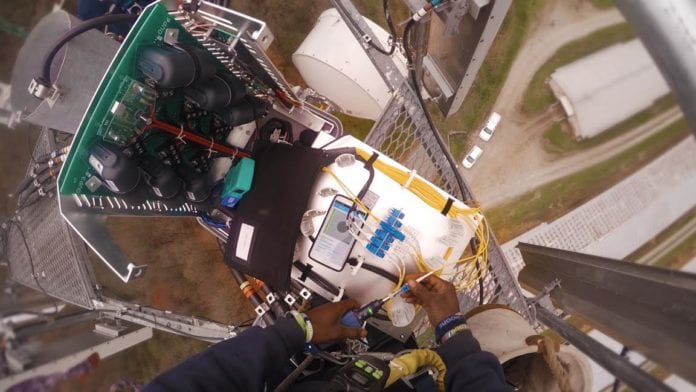Fiber is the backbone of many wireless networks, and in recent years it has also made its way into the radio access networks. One of the biggest developments in the industry has been fiber to the antenna, or FTTA. When mobile network operators move radios to the tops of the towers, they typically use fiber to connect the radios to baseband equipment at the base of the tower.
For RF technicians and tower climbers, this change is significant. While fiber is much lighter than coaxial cable, it is also more fragile. Flaws in a strand of fiber often cannot be detected by the human eye. “If the fiber is damaged, occasionally you could know by looking at it, but [technicians] need to use test equipment to send light and test refraction,” said Jim Riddle, engineering manager for wireless networks at Black & Veatch.
Riddle explained that when technicians send a certain amount of light power, called the link budget, through a strand of fiber, they should expect the same amount to come out the other end. If this doesn’t happen, technicians need to find out where the problem lies.
Imperfections in the fiber itself are often classified as macrobends or microbends. Macrobends are bends that are often large enough to see. Microbends are more complex.
“Microbending is an attenuation increase caused by high frequency longitudinal perturbations to the wavelength,” according to fiber manufacturer Corning. “The physical cause of the perturbations is usually assumed to be due to lateral contact of the fiber with surfaces in the optical cable or other deployments, as well as twists or other extrinsic stimuli.”
A damaged fiber almost always has to be replaced rather than repaired, according to Riddle. He said that typically there is no way to re-terminate a damaged fiber.
Another pitfall for technicians working with fiber is faulty connectors. According to Marquis Dorais, fronthaul product manager for test equipment maker EXFO, even connectors that have not been removed from their cases can harbor tiny specks of dirt that can impede the performance of the fiber. Many suboptimal connections can be corrected by swapping the connector for a new one.
Dorais also said that technicians need to learn how to emulate the performance of the baseband unit by using test equipment. It is important to make sure the tower top radios and the baseband equipment at the base of the tower are communicating as they should. If they’re not, using test equipment to figure this out while a climber is still on the tower can prevent the need for second trip to the top.
Finally, fiber strands are not interchangeable in most cases, and techninicians need to make sure the strands go in the right places. Fibers are connected to the radio by small form factor pluggable units, and often these are active components that perform differently from one another.
“You have to be sure that the SFP is properly seeded inside the radio head,” said Dorais. “You have to insure it’s the correct one [and] you have to be sure the fibers that are plugged into the RH are the right ones.”
Technicians that understand the intricacies of fiber are in short supply, according to Black & Veatch’s Riddle. He also said that successful tower technicians need to understand both fiber and RF.
“You kind of need to span both sides,” Riddle said. “The workforce should be always ready to learn anew because the technology is consistently changing.”
Follow me on Twitter.

